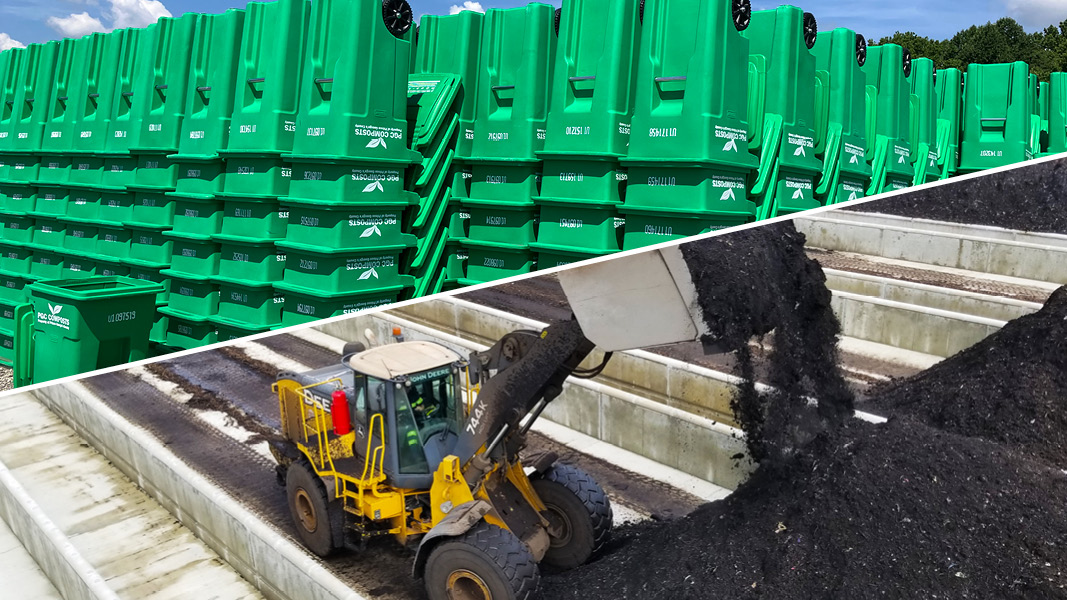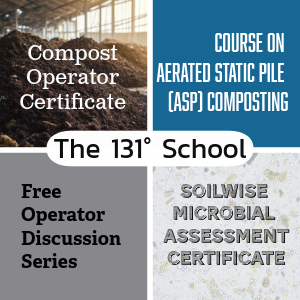Top: Prince George’s County, Maryland completed distribution of organics collection carts (top) in early 2024. Food scraps and yard trimmings are composted at the County’s facility in Upper Marlboro (bottom). Photos by Steven Birchfield
Nora Goldstein
In January 2024, Prince George’s County, Maryland completed rollout of a residential curbside organics collection program to all single-family households that receive county-provided trash and recycling services — about 180,000 in total. All food scraps, food-soiled paper and certified compostable bags and food-contact packaging are accepted, along with leaves, grass clippings, and small branches. Households were issued 32-gallon carts at no additional cost to their existing solid waste fees.
The program, named PGC (Prince George’s County) Composts, launched initially as a pilot for 2,000 households in 2017, and was partially funded by a U.S. Environmental Protection Agency grant. “Prior to this pilot program, households did not have a collection cart for yard trimmings, nor could they set out food scraps for composting,” notes Marilyn Naumann, Associate Director of the Prince George’s County Department of the Environment Resource Recovery Division. “Yard trimmings could only be set out on the curb in kraft paper bags.”
After the initial pilot, two additional expansions of the program were done to obtain data on household participation in a food scrap collection program. The findings were positive, ultimately leading to the full rollout. Some municipalities in the County, including College Park, Greenbelt and Hyattsville, established their own organics collection program, since the County’s curbside organics collection program does not include municipalities. “All households in the County pay a solid waste fee, but the amount is based on the level of inclusion in the County’s solid waste-related services,” explains Jessica Moore, Prince George’s County’s Department of the Environment Recycling Section Manager. “The baseline fee covers costs of our drop-off sites and processing facilities. The highest fee includes trash, recycling, organics, and bulky waste curbside collection, along with electronics, scrap metal, white goods and scrap tire recycling by appointment.”
All collected organics are processed at the Prince George’s County Organics Composting Facility in Upper Marlboro, which is managed under contract between the County and the Maryland Environmental Service, a nonprofit business unit of the state of Maryland. Originally started as a yard trimmings windrow composting facility, the site began composting source separated commercial, institutional and residential food scraps as a pilot in 2013. It selected Sustainable Generation, LLC’s SG Mini™ System utilizing GORE Covers for the pilot and processed about 125 tons/month of food scraps.

The Prince George’s County Organics Composting Facility has a 12 SG BUNKER® System with GORE® Covers, with capacity to compost 57,000 tons/year of food scraps amended with yard trimmings.
Over the next few years, the composting capacity was expanded (still in pilot mode). Ultimately, the County ramped up to a full-scale food scraps composting facility in 2018, installing a 12 SG BUNKER® System with GORE® Covers, with capacity to compost 57,000 tons/year of food scraps amended with yard trimmings. Much of the incoming yard trimmings continue to be composted separately in windrows. In Fiscal Year 2024 (FY24), the Organics Composting Facility processed 17,345 tons of food scraps and 69,625 tons of yard trimmings —a total of 86,970 tons of materials. The most recent addition to the site is a Tiger depackaging system. “It’s only been operating for a couple of months, and we’ve received several deliveries of everything from salad mixes to chicken nuggets,” says Moore. “The unit allows us to process expired items from groceries, restaurants and other generators that are now required to compost food waste under Maryland law.”
Household Engagement
In the collection pilots, households in the targeted neighborhoods were asked to opt in to participate. “We wanted to make sure people who received carts wanted to participate,” explains Naumann. “It also enabled us to get insights into how participation varied among neighborhoods in the pilots. Overall, the feedback we received was positive.”
When PGC Composts was fully rolled out from only pilot participants to all eligible households, the County switched to standard offering where all residents enrolled in County-provided trash and recycling collection received the 32-gallon organics cart and a kitchen countertop caddy. Instructions on why residents were receiving the carts and how to participate were inside the kitchen caddy. There was not a price increase for collection service as the County’s contract with its hauler includes organics collection at no additional cost.
A total of 22,000 households were in the pilot program when Prince George’s County decided to expand countywide. In the first phase of the rollout in fall of 2022, 52,000 carts were distributed to residents. The remainder of the carts were delivered in 2023 and early 2024. Prince George’s County began promoting curbside organics collection to residents in advance of the first rollout, using radio and TV spots, signage on buses and at bus stops, direct mail to households, and ads on Facebook. In addition, County staff participated in community and school events, attended homeowner association meetings, invited residents to tour the composting facility, and more. “We hold an annual event in April at the composting site called Mulch Madness,” says Moore. “Residents can take as much compost and mulch as they can cram into their vehicles. We talk to everyone who comes in about the curbside organics collection service and explain that they are feeding into the program that allows them to feed their soils.”

Households can use certified compostable bags (above) for collecting food scraps. A load of food scraps with jack-o-lanterns adds seasonal color to material received.
There were instances where households contacted the County via phone or email and wanted the cart taken away, noting they weren’t given a choice and didn’t give permission to have it dropped off. The primary complaint was not having space to store the cart, although a handful of residents cited the potential for smells or vermin. “We allow households to use certified liner bags for the caddies, but do not provide them, and they may be difficult to find,” notes Naumann. “We do tell residents they can use the paper yard trimmings bags in their carts to put the food scraps in to keep potential wetness contained or absorbed.”
Adds Moore: “In our face-to-face interactions with residents who are resistant to participate, they feel the program is complicated to use based on the instructions that came with the cart and caddy. We spend a few minutes showing them what to do and tell them it is okay to just start with items like banana peels and coffee grounds, which aren’t perceived as ‘icky’ in most cases. Next, we suggest they start adding in other fruit and vegetable peelings. This helps create the realization that it isn’t hard to participate, and as they get more involved, maybe they will start adding their plate scrapings, etc. We’ve found it is key to communicate three things: the program is a way to help fight climate change, it isn’t hard to separate, and it isn’t all or nothing in terms of what they add to the bin. If we can get those three points across, it will go a long way to getting the program used more than it currently is.”
Naumann says that when Prince George’s County offered households curbside recycling many years ago, the County didn’t experience the same kind of slow participation uptake rate. “We used a similar outreach and education approach and got very high participation almost immediately,” she says. “Few requests were made to pick up the recycling cart. That’s a stark difference than with our curbside organics collection program.” No plans are underway to mandate participation in the organics program at this time.
The County continues to assess the most effective engagement tools in promoting the curbside compost program. Participation is growing, but not at a rate anticipated. “It comes down to behavioral change,” adds Naumann. “This takes time before it becomes routine, like sorting recyclables from trash. We’re also surveying households to get direct feedback on the program and what works and doesn’t work for them.”
Face-to-face engagement continues to be effective. Another pathway to participation is through programs at Prince George’s County K-12 schools. The County received a grant to set up food scraps collection and food waste reduction in 12 schools in 2023, and 24 schools in 2024. Students divert any leftover food into green carts; food taken but not opened can be placed on share tables in the cafeteria. “We intentionally decided to use the same carts as the residential curbside program to help reinforce the same behavior at home from the children’s point of view in terms of food scraps recycling,” notes Moore.
Measurement Matters
Prince George’s County does not track the number of households that set out their green carts at the curb each week given the logistical challenge, adds Moore. Instead, it has been doing truck sorts at the composting facility after the contents are unloaded. The sorts are done quarterly; each one evaluates two truckloads from different service areas in the county.
County staff measure the percent of the load that is food scraps, yard trimmings and contamination. The first sort was done in August 2023 and food scraps represented about 2.5% of the load. The second sort was done in March 2024; 7% of the load was food scraps. “We’ve found participation rates vary by service area,” says Moore. “In one area, 17% of the load was food scraps while another area only had 2%. There was contamination in the load that had 17% food scraps, but we are getting more food. The two don’t necessarily correlate, because in other loads, there were higher percentages of food scraps, and they were not highly contaminated.”

Carts are manually tipped into the rear-loading collection trucks. Workers flip the lids and if contamination is visible, the cart will not be serviced.
Carts are manually tipped into the rear-loading collection trucks. Workers flip the lids and if contamination is visible, the cart will not be serviced, and a tag is affixed explaining why it wasn’t emptied.
The County is challenged by the lack of measurement methodologies when collecting commingled food scraps and yard trimmings in terms of dissecting how much of each stream is in the load. Staff has been seeking data from similar programs around the country and has not found benchmarking data to use. “We’d like to get an idea of what the goal should be in terms of percentage of yard trimmings versus food scraps in programs like ours,” explains Moore, who is participating in a session organized by BioCycle at COMPOST2025 in Phoenix in January on food scraps measurement in residential collection programs.

Food scraps compost is sold in bulk as Leafgro GOLD®.
Over the next two to four years, Prince George’s County expects to see household participation in the curbside organics program grow to a minimum of 40%, especially with continued investment in outreach and education, says Naumann. “We also are promoting wasted food reduction in this program. Our milestone ultimately is 85% participation, when diverting food scraps is just as normal as recycling.”














